Mickey Mantle Left Handed Swing Hitting Home Runs | Analysis, Height, Strength, & Switch Hitter Left Right Split Stats
Mickey Mantle: How To Increase Batted Ball Distance When You’re Not Throwing A Javelin?
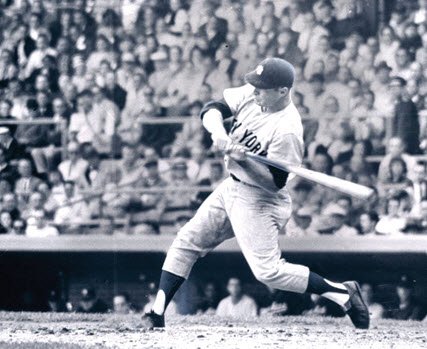
Check out Mickey Mantle’s bat lag. Photo courtesy: LegendaryAuctions.com
This post looks into Mickey Mantle’s left handed swing, hitting home runs. We do swing analysis, look at his height compared to current players, strength, and share a bleacher report article with his switch hitting left right split stats. We’ll also compare his swing principles to an Olympic Javelin thrower!
Since publishing the YouTube video, it has amassed over 148,241 views and 500 video “Likes”.
The basic premise of the above video is to compare Mickey Mantle’s right handed swing mechanics to Czech javelin thrower, Jan Železný’s throwing technique. Jan is a world and Olympic champion and world record holder. He also holds the top five javelin performances of all time…according to Wikipedia.
In the video, I brought up my favorite Ralph Waldo Emerson quote many of you have seen me post before:
“As to the methods there may be a million and then some, but principles are few. The man who grasps principles can successfully select his own methods. The man who tries methods, ignoring principles, is sure to have trouble.“
SCIENCE-BASED TRAINING:
Improve your hitting strategy dramatically by applying human movement principles.
Learn not only how and what to train but also the science behind the methods.
The human movement “principles” we’re comparing in the video are:
- The Un-Weighting Principle (or Forward Momentum), and
- The Catapult Loading System.
The reason I picked “The Mick”, is because he wasn’t really a big guy, according to Baseball Reference.com, he stood at only 5’11, 195-pounds.
Don’t get me wrong, Mickey Mantle was a naturally strong dude. But he wasn’t the size of today’s behemoths:
- Giancarlo Stanton (6’6″, 240-pounds, 3% bodyfat),
- Miguel Cabrera (6’4″, 240-pounds), or even a
- Mike Trout (6’2″, 235-pounds).
And, some of The Mick’s dingers have been the talk of folklore, claiming to have traveled over 600-feet!
Although with the computation of Metrics now, as Christopher Harbour, a YouTube reader commenter on this particular video, put it:
“The farthest official home run in MLB history was hit by Babe Ruth in Detroit at a distance of 585ft. Mickey’s longest shot was 510Ft. It was often claimed to be much farther but that distance was the distance AFTER the ball rolled. This info is proven by SABR historian Bill Jenkinson.”
Whatever the case, it’s still amazing that a guy of Mickey Mantle’s stature, can hit a ball over 500-feet! We don’t see Giancarlo, Miggy, or Trout doing that.
And by the way, everyone thinks Babe Ruth was this hulking mass of a guy…he was only 6’2″, 215-pounds. And according to the above comment, launched the longest dinger 585-feet!
So what was Mickey Mantle doing mechanically making him so special that we as coaches should be teaching our younger hitters?
Mickey Mantle on the Un-Weighting Principle (or Forward Momentum)
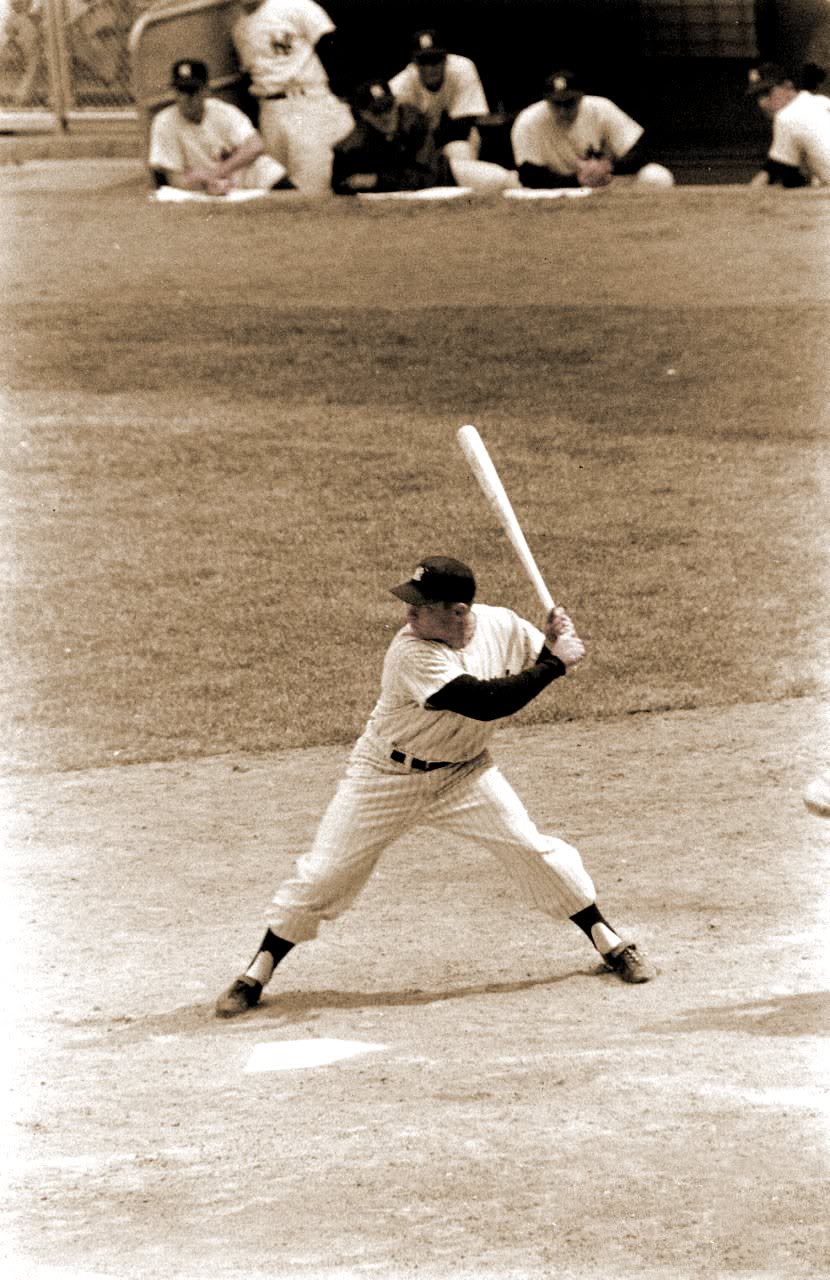
Look at Mickey Mantle’s shifting foot pressure… Photo courtesy: http://s685.photobucket.com/user/BillBurgess
I said in the video that The Mick’s back knee wasn’t floating over his ankle, but that’s simply not true. This was knowledge residue from past baseball experts I was listening to at the time.
What Mickey Mantle did really well was shifting his foot pressure.
We can see from the moment he lifts his stride foot to that foot touching down that his foot pressure looks like this:
- Back foot pressure – is on the outside, and
- Stride foot pressure – is on the inside.
This is similar to a story one of my readers, Stephen Reid, shared about prolific golfer Ben Hogan (5’9″, 145-pounds), saying in an email:
“A friend of mine worked at Shady Oaks in Dallas where Hogan played and practiced. Towards the end of Mr. Hogan’s time of ‘grinding it out of the dirt”, he was allowed the opportunity to sit and watch him hit balls. He said that Mr. Hogan started talking about the stance, and he stated that the way he thought it would come to pass in the future would be that both feet at address would both be turned slightly towards the target- 30 to 45 degrees. By turning the right foot in at address, the golfer would essentially be putting a governor on his/her right side.
He also reasoned that by doing this, the player would create the tension and brace with the right side and would create a strong coil that would not allow for any “over-coiling or over-swinging”. Therefore, you would be presetting the coil or brace of the right side in a controlled manner and would not allow oneself to overturn in the backswing. Conclusion was that the energy from a strong brace and controlled coil, the golfer would create greater energy in the release of the right side while creating greater swing speeds through impact.”
As Mickey Mantle’s stride foot lands the foot pressure shifts as follows:
- Back foot pressure – moves to the inside, and
- Stride foot pressure – moves to the outside.
Mickey Mantle is also most certainly picking up his stride foot and leading with his hip forward. Just pick out a point of reference in the background, and track how far his hip moves forward. He’s effectively ‘un-weighting’ his bat, or getting a “head start”, to make the transfer of linear momentum into angular (or rotational) easier.
And we can clearly see the Javelin Thrower, Jan Železný, using forward momentum sprinting down the track before slinging his “arrow” A LONG WAY.
The Catapult Loading System
The ‘Springy X Pattern’ I developed through reading the book Anatomy Trains by Thomas Myers. Watch the following FunctionalPatterns YouTube video of Thomas Myers talking about the concept of Tensegrity, or Tension Integrity:
It’s the idea that there are compression and tension forces acting within the body at all times. In the Mickey Mantle video, I talk about imagining a big ‘X’ on his chest and back…connecting one shoulder to the opposite hip. The fascial lines are a little more complicated than this, but let’s take a general look at how this works…
When Mickey Mantle pre-loads his torso – before turning – we see his lead shoulder come down and in towards his back hip (one leg of the ‘X’ shortens), while the rear shoulder and front hip move away from each other (other leg of the ‘X’ lengthens). And the reverse is true on the backside.
This is evidenced by tracking his LEFT shoulder:
- Pre-loads DOWN before Final Turn,
- Unloads UP during the Final Turn, and finally
- Reverses DOWN during the follow through to decelerate rotation.
CLICK HERE for an interesting article titled “Muscle Power Golf?!…NOT!” by Kelvin Miyahira (big thanks to Stephen Lowe for the link). It talks about how the swing – whether we’re talking baseball/softball or golf – IS NOT about activating fast twitch muscle fibers, but engaging the springy fascia. It’s a rant that I wish I did FIRST!!
Other Interesting Resources from Mickey Mantle YouTube Viewer Comments & More
-
Marie Louise Hunnicutt book recommendation – Baseball’s Ultimate Power: Ranking The All-Time Greatest Distance Home Run Hitters
by Bill Jenkinson
- Gabriel Pennington – “Mantle’s massive strength came from blue collar work, swinging a sledgehammer in a lead mine (on top of freakish genetics). Couple that with the workman mentality of your best never being good enough and you have a lethal combination for an athlete.”
- koryguns – “3.1 seconds to first. Legend has it when he was a rookie in 1951 they decided to have a foot race among the team. Mantle beat everybody like they were standing still, puked, and apologized to Stengel for being out of shape.“
- Here’s the BleacherReport.com article with Mickey Mantle’s left right split stats titled: “Mickey Mantle Almost Gave Up Switch-Hitting in 1960”
Also, here’s slow motion video of his left handed swing…
- Fix Your Child’s Fear of the Ball Fast: Proven Hitting Drills to Stop Flinching at Pitches—Trusted by Top Youth Baseball Coaches - July 12, 2025
- Fix Your Little Leaguer’s Hitting Slump Fast – Proven Confidence Drills & Mental Reset Tools (Used by Top Youth Baseball Coaches) - July 9, 2025
- Best Hitting Drills for 8-Year-Olds (2025): Fix Swing Flaws Fast with This MLB-Trusted Youth Baseball System—At-Home, Step-by-Step, and Built for Game-Day Confidence - July 5, 2025

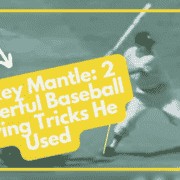

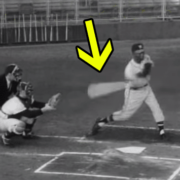
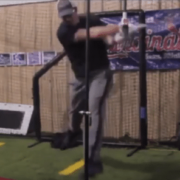

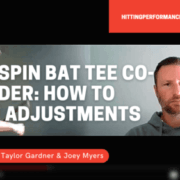
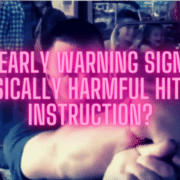





I am also noticing his hips lowering before the stride. I’ve been working on trying to clean up my players’ strides and I think this is the key to doing that. In my mind it’s kind of a sink and lean to initiate FoMo. I also notice that Mickey started in a preloaded position of the a CLS in his stance. I have played around with this also and it makes the introduction of the CLS a lot smoother. One other thing that I picked up yesterday while reading the thread with Jim Sullivan where you referenced a golf coach, Lee I think, who advocated a slower swing could result in more distance bc of body positions. Without even seeing the info from the interview, I know and can attest to that info working. While in college circa 1998-2001, in spite of being a prestride guy, I regularly hit balls in the 410-440 range with the old $39 Louisville c243. The one thing I focused a ton on was keeping the barrel slightly behind my hands at contact, which I now believe helped me stay more rigid at Impact so that I could apply more of my 6′ 205 lb frame to the swing masseimilar to your 30mph train vs 60mph motorcycle… sorry for the long post
Great observations Coach. Yes, the pre-loaded CLS position can be done at the start of the swing (Mick did this for sure on his lefty swing), or the hitter can move into it after the start of the swing. What Lee, my golf instructor friend, highly recommends is strategic finger pressure. Bottom three fingers of the top hand to be as tight as possible before, at, and through impact. This can slow down bat speed, but it allows the synovial fluid in the joints to harden, and transfers impact to the skeleton, not the soft and connective tissues (which disperses energy). It also empowers the hitter with more bat control. This is coming from my own personal experience on Zepp swing experiments.
Great article!!!For this to work the right way, controlled back side to exploding to the the ball, the hands are key… The bottom does its thing but the top does it too… By using the fingers you can get you feet to flatten and your front side to be dead weight for a great snap… So you can channel your energy with great free moving hinges…The fingers have two big time nerves that also get the thigh involved along other things…. ~DM
Im new to all the cues… But I’ve heard “fast hands” but it seems to be used very loosely… But try punching with a closed fist and than try punching with a similar open fist while starting with the pinky… The bottom three fingers spin the hand while the thumb and index finger rotate or are the action… Somewhat? But knowing that is key to fast hands… I’m not sure the baseball people use it that way but ask Anyone who seen Bruce Lee movies if there is such a thing as “fast hands”.. It all ties into the swing being preloaded and coiled… I believe Joey had an article about the bottom and top do there things around the torso… Meaning the top isn’t just hanging on… It’s also active and working with the bottom… sort off… Later Joey thanks for the video…~DM
Question? If your top hand specifically your bottom fingers start loose and you tighten them with the pinky, ring than the middle finger in that order…does that give the batter a lean in… A counter rotation…than what if you used your bottom hand afterwards…
For me it makes a world of difference…Using what seems to be the median and ulnar nerves…it seems like a trigger or information carrier which if trained well just goes and does the job…
Maybe Joey can shed some light with these points either being proper or not… This approach seems to work for me…Any thought Joey? As usual your time and comments are appreciated. Thanks! Later….
~DM
Part of me thinks if your coiled… You can lean and squeeze the top hand bottom 3 fingers in sequence and that makes your front side in a state of “dead weight” or just loose… And that just picks up your lead foot…making it the start of the swing….For me this works, I’m just wondering if it’s my specific stance and muscle memory or is it just how it it’s done…I’m just brainstorming snd trying to add to the conversation…~DM
Djura, interesting observations. The challenge is if we get too involved in creating many small steps to lead up to one big one, I think we lose the broad strokes idea in translation. In other words, we can talk about tightening the top hand pinky, then ring, then middle finger, but to a hitter, I think, this would be TMI. I keep it simple, just squeeze the bottom three of the top hand as soon as the hitter lifts the stride foot. I’m interested in what you saying about the two nerves. What the finger pressure activates is the fascial sheets interconnected throughout the body. It’s also taking the liquid synovial fluid contained in the joints, and making it solid pre- and at impact. This is the difference between the ball feeling like it’s hitting a piece of cement, or a wet pool noodle. Great thoughts as usual brother!
Awesome stuff about being solid… I just called that “getting strong”… Yea, I would assume that teaching some of this can be really difficult… I do think that not only on the start of the stride but even on the back swing and forward swing that the fingers work in a sequence(s). I think it makes the hands faster which helps lag and additionally helps the batter get the barrel connected to the handle as I think that’s key to getting bat speed…Among other things…I do think the nerves in the fingers/forearms activates the thighs which if loaded and coiled can be key to timing…Maybe when I have time I can do some reasearch and give you a better explanation besides my own observations….As far as teaching… I’m clueless and your most likly right that it’s too much info… I told my 7 year old… I just told him to be mindful… Actually I gave him a drill… I told him you have 5 mins… Just swing the bad in a thousands directions and ways… When swinging just use different sequences and notice what the bat does and notice what feels right, wrong, string, weak…I don’t think it’s doing any thing but maybe in a year or too it might who knows… I have no idea how to teach this stuff that is why I’m always looking to you… Happy holidays Joey!!! Later…
Djura, no rush on the research, I’m always up to learn something new. And remember I don’t have all the answers. To summarize an Albert Einstein quote, he said something like, “Make it simple, but not simpler.” There are different learning styles (visual, auditory, kinesthetic), and it may take multiple coaching cues to get your hitter to apply what you’re teaching. I just know from the research that minimal feedback (from us) is better. Not zero feedback…minimal. Because they still need feedback, just not too much. As always, I appreciate what you have to say Djura, and I hope your family has a Happy and safe Holiday season as well 😀
I was think about the hands and nerves since baseball season is around the corner from us here in Florida… One thing I failed to mention is presetting your body (hand grips, shoulder joints, forearms, hip joints, bottom hand-pinkie …etc) will produce varyed results and people having different body types (lower back, pelvis tilts, flexibility …etc.) will also produce varyed results…I think it’s extremely difficult to talk about the particulars of the swing without looking at the bigger picture and how it all the particulars ties in…For example we all look at the torso (.i.e., the core- some say pelvis and lower lumber others the whole…) and additionally leveraging the ground…. All well known!!! But I don’t remembered, Joey correct me if I’m wrong, many people talking about leveraging the body against the bat…If you can move your center of mass using the ground what about using the weight provided by the rod that we swing…and obviously you can manipulate that rid with your fingers.. What say you?
Djura, are you talking about Conserving Angular Momentum principles, like early arm barring? I’ve been picking Perry Husband’s brain lately with his Effective Velocity system, and there are some real nuggets coming out of there. Go to http://www.HittingIsAGuess.com for more info on that.
Remember Joey my premise is your loaded, coiled, stretched…etc…which means the triggers don’t have to be larger in order to start something… A contraction, unloading or uncoiling…etc… Question if you just apply pressure with your fingers and that rotates your hand, does the rotating hand move and if so can it move( twist) without it moving forward…additionally if your all twisted ready to rotate, can a force perhaps a linear force applied by the mass of a moving bat contribute to said rotation…Perhaps a downwardly force from behind…just brain storming…I guess!!! I think it’s hard to talk about the swing without knowing exactly how the batter is approaching the ball…at the end I think that there are many forces applied to the body In order to hit…those nerves in the hands are important!!! It all adds up… Also, my thoughts are the whole thing is about large muscles, momentum…etc…are produced in order for the batter to rip the handle off the bat with the hands…Sort off!!! Any thoughts would be appreciated… Later! ~DM
Djura, I’ve tried moving away from muscles explaining the gather and release of energy in the swing. To me, I think the tension/compression forces inherent in the springy fascia is much more critical. Not sure if I suggested Thomas Myers’s book Anatomy Trains, but I think with your understanding of the swing, you’d LOVE it!
Not sure, I will try to check the book out when I have time…Why have you moved away from teaching the muscle and I assume joint movements. Too me it’s the key while that compression stuffs seems on point, it’s more natural when taking a swing especially if your muscles and joints are in the correct sequence…
Arm barring is another one of those things I have a hard time explaining… Remember, I never grow up with thes terms I just hit…Remember my premise is everything has an affect ib the swing which would need a counter to balance the swing… In a broad sense you need to arm bar but than you need to manipulate other specs in order to keep balance or else it doesn’t work… And to what extent of barring is important too…But everything works together and that is why I’m highlighting the leavage the batter has in view if the bat which weights 32+ oz….which also means if you leavage against the bat you MUST leavage somewhere else to compensate in order to be balanced…Anywhy I think I’m going off in a tangent again…
Any thoughts would be appreciated Joey. Later! ~DM
Djura, withing myo-fascia, bones and muscles would fall to the floor. According to Thomas Myers, fascia is a cotton candy like material that the bones and muscles float in, and what gives muscles their shape. They’re responsible for the compression-tension forces in the body. This is how what you do with your top hand bottom three fingers can be affected by the last three toes of the stride foot. Tension is what keeps the body connected in movement, not being loose. In other words, loose muscles are not fast muscles. I’m not saying muscles don’t do anything, I’m just playing the Devil’s Advocate here, when people try and argue that body movement is all about firing fast twitch muscle fibers…because it’s not.
I think I mentioned I wanted to write a book and maybe I’ll do that but I’m not sure if my ideas are mainstream or not… Nonetheless at the CORE of my understanding of the baseball swing is how your leavage the bat with your hands/wrists and how yor shoulder joints connect you to your torso… And how your feet/ankles leavage you with the ground and connects you to your torso…. And how your center of mass or “core” is the focus of all movements… So everything is about your center of mass….And how your leavaged against the ground and bat… In physics I think you can just say big gear little gear….None the less if you move the little gear to get the big gear moving….who cares…What does this or that means nothing, but how the gears what amongst the system is important… If your connected CORRECTLY, than a little finger movement does things to get you started that if observed is key for me… Additionally, a little movement in your finger is upper… So according to my theory, where would the lower “counter” be… If you don’t know that you fail to understand the sequence… If I drop an apply I know what happens…Perhaps I’m wrong but when I drop an apple I know what happens…
Djura, so the opposite move you’re asking about with bottom three finger pressure of top hand, actually is the last three toes of the stride foot. It’s reflexive.
Same thing here… By the way I hope I’m not boring you…But once your connected to the ground, torso and bat correctly…it’s easy…. Effortless while your shoulder down to the figers are just guiding the bat and loading but not even close to pushing those muscles which make it very quiet in the upper body…But joint and muscle manipulation is key unless I fail to notice the spiny compression force and just think it’s muscles…Nonetheless I just feel force and label it that way..,The way I see it is… You coil every thing and if it all centers along your center of mass so therefore it all works kind of like a complicated sea saw… What happens to one side but happen in the other… Once your coiled… Both legs, both arms, both ankles and wrists and using your hip joints and shoulder joints to transfer the energy from your big motor to your little motor….But they ALL need to be connected to the torso which means to each other…So any movement can start it and all you do is channel the energy from the big motor to the little…which ends up breaking the handle off the bat and really moves… Kind of like throwing a big rock of a bridge that is tied to a little rock… The big rock is big and the rope is little… Who cares about either lif the little rock is moving really fast once the rope pulls on it…I guess we can say the rope is small, weak… How can that little rope move such heavy things.. I say lets talk about the whole thing… It starts with a finger movement… A foot movement… A wrist movement..An ankle movement…the tibia movement…a forearm movement…etc… I think you can see where im going…. When I do that I know what my swing does with every slight movement….And I think for me its the swing… Learning how to make adjustments is key afterwards.. Ok I did it again… Later..
I totally agree with you that the power is in manipulating joint-tension relationships. But we have to look at a dynamic movement, like the swing as one whole piece, because if we teach on a piece-by-piece basis, like most kinetic chain enthusiasts, it’s more difficult for the end user to put the puzzle pieces together. So how do we as coaches teach in chunks versus in puzzle pieces? With fascia tension cues. Squeezing the bottom three fingers of the top hand will create the necessary tension to link big “chunks” of body movement together. And might I say, it’s a very easy cue my 7yo boys and girls get.
Ok.last thing I don’t know if you know this or disagree but if what I’m saying is correct…IF… I guess… Than the best way to coil both legs is to get grounded and into your hips… Perhaps a hip hinge.. Than use your hands/shoulder/fingers… Two nerves…to rotate your arms inwardly and get into a regular stance… Watch how you grab the ground and pitch all the right muscles with out think.. It’s natural unless told otherwise… Remember if your legs don’t coil enough you didn’t coil your arms enough which is key… Pull those elbows in hard and push up at shoulder joint/scap to pitch and coil correctly… Once set up…. Your legs and arms are connected… If you rotate than the legs will leavage the ground to generate energy to channel to the arms…If this is true… Well it’s not a perfect system…There’s lost of energy… But you have to know how to leavage the bat… And know that any movement in one area WILL have an equal movement moved by one of the smaller or big motors…so move the hand to move the foot which leavaged the ground to move big muscles to your hand….Than rip the bat away like the rope ripping the little rock….Just get connected…and every movement is big from the big misled no matter how slight… Every little movement from small muscles is fast…It channels quickly…Alright Perhaps I’m wrong or need to read more but it works Everytime for me… So every movement kind of starts somewhere else….So for example your lead foot is 65 degrees for balls down the plate… But moves more or less depending on your lead hand…Or said another way stop looking at your foot and hand if your connected… It falls in place…See ball hit ball… Once your connected!!! Later.
~DM
You crack me up! Djura, seriously read Thomas Myers’s book Anatomy Trains, it’ll help fill in the spaces that you may have right now. It changed my life 😀 I love you sharing because it gets me thinking.
Again equal opposition forces scaled to said motor… Leg abduction than shoulder shrug.. You lead leg rotates and gets straight… Your lead arm swings and gets barred… Your back leg turns and bends and your back arm turns and bends (slots)…I guess you get the point…I hope I’m making sense… It’s hard to type on my phone… I’m really done and I think I got some major points into the discussions while misspelling every 5th word… Hopefully you find them interesting…Later! ~DM
Last… Just in case you missed my point…equal opposite… If you coiled both limbs to max than all turns, bending, flexing matches… If you have a little bend… Most likly you didn’t coil fully…Seriouly… I’m out!!!
I totally agree Djura!
So just in case I’m misunderstood…. And I’m not saying this is a perfect science or I’m right but this always works for me… Just like dropping an apple… If your connected… Left arm coil ( rotation) to left leg coil ( rotation) and all the rest… Than you can start the swing by using your left hand and this starts your sea saw… It starts the back swing… Than this automatically gets the legs to leavage the ground for the forward swing… You know those big muscles…so know quashing bugs as that happens naturally…. Like all of it… So you start the sea saw with the little rock and the big rock… The little one was applied to the sea saw first and than the big rock was applied second…Well watch what happens…So…. Get connected…. Move those fingers slowly… Observe what your system does…. It should be natural and any different body types can be adjusted… So if flexiblity are different than it would be noted… Said another way… If I were to teach the first thing I would do is get a body motion chart and measure all the flexions… So if somebody has flat feet his ankle motions may not do what you want which just needs some work… Perhaps isometric resistance workouts in order to find the flexion and what muscles move it….remember as you know multiple muscle can move joints but the batter wants a particular set of mindless to move the joints as you may cut the link ( connection) if the batter uses the wrong misled…And ankle motion, hip motion, shoulder motion, wrist motion, spine motion are all tied into each other… Any kink will lose the transfer….and that compression stuff is fine but squeeze your bottom three top hand connected and connected… The feeling is different… Man I can go on for ever with this…Later…This is perhaps one of my last comments… Later! ~DM
Perhaps I should read the book… So if your that stuff shapes your muscles does it work with both hands… I usually would bring my bottom hand fingers involved too so would that shape muscles too… I thought I was setting my shoulder joints in order to “bar” my lead arm and set my front side to become “dead” or relaxed prior to the start of everything… So does that stuff work the same way in both sides of the body or does different nerves/triggers make it do different things… Man I don’t really have time to read a text book with new ideas… How long is the read?Thanks…
EVERYTHING is connected and effected by springy fascia. The book is somewhat long, but definitely worth the read if you REALLY want to understand the swing. However here are two videos with Thomas Myers (author of Anatomy Trains) talking about the principles of fascia: 1) What is Tensegrity, 2) Tensegrity Applied to Human Biomechanics.
Ok those videos just BLOW my mind…. It was like the connection of how to communicate what I was thinking for the past few years…I’m assuming the tension/compression thing works the same way but if your joints and/or muscles are set differently than the tension/compression manipulates the body differently… So when I’m connected bat to ground, moving my fingers moves my toes… And when I purposely disconnect (lose my spine angle and back hip) the same movement does not exhibit the same results…. Interesting…Well would squeezing the the hands in a pattern ( for example one after another) build momentum or how about the fingers…. All joints…like the triple pendulum… Shoulder, elbow, wrist…etc…. Interesting indeed… So where is baseball swing theory going with the compression tension understand….
Hey Joey, I don’t wanna ask for free advice but I haven’t found any videos about teaching basic REC kids… So if you have time do you have a 3 notion type combo to help a REC coach get by another season…. Some of these kids never played before and it makes it feel nearly impossible…. So if you have 3 pointers that can easily performed with big results absent the basic stance that would be appreciated… I would assume squeezing bottom 3 fingers would be one since you said you had results and that in itself seems to help the batter get connected with the ground naturally… What about 2, guess where the ball will be… I coach 7 and 8 year olds and see them just once a week and have a group of 12…. It seems like a like I can’t teach them… I was going to start with 3 basic points that work well but haven’t decided which ones but think squeezing bottom 3 is a must… What about back swing forward swing while showing it… Do you think 7 and 8 years can pick that up…Than I have to deal with all those people who see the swing backwards…. Any help would be appreciated for this age and the fact that t really don’t have the one on one time…Thanks…
Djura, you can’t expect a lot out of 7/8 year olds…at least in being specific with your teaching. I’d say focus on 1) getting them to be the best at playing catch (defense), 2) getting pitchers to locate the ball and utilize Perry Husband’s Effective Velocity system (no breaking stuff), and 3) getting them to squeeze the bottom three. I think they’d be hard to beat with those…
By the way, I know you didn’t like the sequence finger thing as a hard sell for the kids but I think the fingers do lock particular joints so everything falls in place…It could make it easier, so my pinkie effects my shoulder joint and my middle finger locks my elbow…This is during the swing… I have multiple grasping pressure I apply to the handle pre swing and during the swing…Forward and back… At any rate I don’t know if these particulars are for me only or a principle of some sort…Perhaps for another day…and I’m pretty sure the sequence of fingers are faster… Now how the tension and compression things falls in would be interesting… So, can tension/compression have a momentum force… A particular feeling or timing with a sequence or without one… I wonder if martial art secrets or no how’s would help…I once read finger and hand movement ideas from drumming when dealing with speed that the was interesting but that’s dealing with a little drum stick… Interesting none the less… I’m out! Later Joey! ~DM
Bottom three finger pressure of the top hand is a great start. You’re right, it solidifies the synovial fluid in the joints, just like what happens when a player catches a throw. Same thing. A loose hand is a non-connected hand (to the torso).
Bye, that I why I think setting bottom pinkie and top forefinger/thumb prior to the swing is important…they lock shoulder joints and set up for roll over without having to think much… So bottom hand middle/fore (bottom hand thumb is wrapped around and out of the way) and top hand pinke to middle are connected and either used bottom/top (middle in) or top/bottom middle out….I think as the fingers go… They start opening and closing the right doors automatically.. Ok I’m really out…later…
Thanks Joey! Your stuff is great… Yea, I’ll try those 3 for now. We do machine pitch down here at 7 and 8… It’s crazy, it goes 40 mph…Some kids never played before. It’s unreal. I like the catching thing. I usually say the best fielders are “only” the kids who play catch best… Not sure if the kids take it to heart but I’ll keep on telling them…Your explanations are awesome. Thanks…Later.
Anything to help brother. Learning how to play catch at their age will pay off in spades in the coming years. They’ll WIN way more games having the ability to play catch in Little League (not that winning is everything), but it’s a great example of put the work in, and the results will come.
Ok… I looked into the fasica thing… I didn’t look at your recommended books as they were expensive and long… But looked at some diagrams and articles…basically have a general sense of what this fasica is and how it applies to the swing…. Your right!!!!!! It tied it all…. I actually thought I knew it all just about…For some reason I don’t remember everything I did but remember how it all felt… By understanding fasica and what I already knew I took a bat and started moving… Not swinging but all my little movements and the feel was there…I’m about 38 and felt like it was 10 for a few mins… It was weird but still it’s all there…. Almost like a secret but I guess it’s known by many…. I guess the secret is how to teach it…. It’s funny everybody thinks do something for ” muscle memory”…. But if you only do it one way… You don’t have to think about it that way…. That’s how you do it…. The so called ” muscle memory” is more about undoing… Either way I’m going off on a tangent. But… Yea I learned some new things. Thanks… And have a clearer view of the whole thing…. It’s almost weird…. It’s so complicated but hindsight is a bitch…. Seeing it so clear now… It looks so easy!!!! Teaching it will be hard based on others…. Thanks Joey… The fasica was it… The missing link!!! I’m out. Later….
Awesome Djura! Glad you found some articles on fascia that made sense. The best thing to do to further your knowledge into it (assuming you don’t buy the books) is to search on YouTube for “Thomas Myers” interviews. He’s the BEST I’ve seen at putting fascia science into words that create images in the brand that help with easy association and understanding. Keep up the good work brother!
Thanks again… I’ll buy the books because to me, right now, it’s all fascia… My son plays soccer… And my daughter will turn 5 soon… So I’ll be there for them…. As this all applies to all movements…ill be Helping them move there body effectively if they want my advice… I’m still amazed Joey!!! I don’t even know how to answer questions about the baseball swing… I feel like most people will think I’m from Mars… The fact is its so complicated for the ones who don’t know… But it’s really not!!! Man you really nailed it… Now seeing all the timing and other things you do… Really gives me the bigger picture that your striving to understand… Really excellent work and the fact you give the public so much free content is really appreciated… Thanks again!
Man I’m sitill AMAZED!!!! crazy…I was really close too…
Questions????By the way have you discussed educating the hands..I think that is so important… Or the top part of the spinal cord and squaring the ball…. I know many think it just there for the ride… Shoot I think it turns counter to the mid part…and the Lowe just goes with the pelvis… Well you know what I mean… That little neck or top part is so important to me..For example, put a book in front of you… You get squared to it…move it and you automatically square to it…. On my youth team… Many and I do mean many kids don’t start square to the pitcher… I always started that way and coiled or winded with that focus and never losing that perspective… Or that primary focal angle…So my head turned, tiled and stuck out…in order to keep that perspective while getting loaded every where else…. Maybe it’s me but I can’t beleive people watch the ball sideways… Kind off… Even if it’s a little…Why would they do that???? I always focused with the inside part of my dominated eye…and coiled around the center of my chest…. Isn’t that normal??? Sorry about the long question…Any thoughts are appreciated….later!
~DM
Thanks Djura for the the kind words brother. But I can’t take all the credit, Thomas Myers, et al. really illuminated effective swing mechanics for me. Actually the head (or chin) drives the effectiveness of the swing. Where the chin goes, the body follows. It’s the center of the movement universe. Check out this link that talks about a study on head movement: http://gohpl.com/1fsKRDf You will love it! It will answer all your questions (under the “Physically Impossible to Keep Eyes on the Ball” subtitled section)…